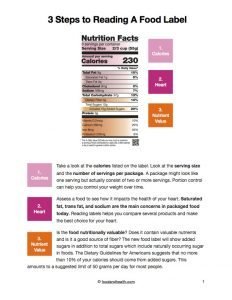Skip These 3 Food Label Mistakes!
As the new Nutrition Facts label starts hitting the shelves, I can't help but notice that people still make the same 3 mistakes as they evaluate a food. Today I want to use the take-home 1-2-3 series to address that!Common Mistake #1: Believing the Claims on the Front of the Box Instead of the Nutrition FactsThe Nutrition Facts are firmly regulated, which means that manufacturers don't have nearly as much wiggle room to make their products look more healthful than they really are.However, the front of the box is fair game.Be wise to claims like "made with whole grains" and "full of vitamins" and check the Nutrition Facts and ingredient list to verify what you're seeing in the advertising. Often foods that are "made with whole grains" also use quite a bit of refined flour (look for only whole grains in the ingredient list to check this claim). Options that are "full of vitamins" often have less of the percent daily value than you'd expect. Daily values are in the Nutrition Facts label -- check those to see what the vitamin and mineral profile of a food is really like.Common Mistake #2: Mistaking Foods that are Sugar-Free or Fat-Free for Foods that are Calorie-FreeJust because the packaging is crowing about its lack of sugar or fat does not mean that the food itself doesn't contain calories. In fact, fat-free foods are often higher in added sugars and refined grains in order to compensate for their lack of fats.And even though a food doesn't contain sugar, it might not necessarily be skipping honey, syrup, or other sugar substitutes. Foods that replace sugars with sugar alcohols or other calorie-free sweeteners are generally lower in calories than their sugar-sweetened counterparts, but they're not necessarily calorie-free, so keep that in mind as you shop.Common Mistake #3: Ignoring the Label Entirely
Homework and Handout:Check a few boxes, cans, and other food packages in your pantry or refrigerator/freezer. How do the claims on the front of the package measure up to the facts on the panel? Highlight the most useful sections of the Nutrition Facts label and either bring them in to your health educator to discuss what you found, or take a picture of the labels for your discussion if the food is perishable or hard to transport.And here's one of our most popular handouts, all about the new Nutrition Facts panel. Oh, and have you seen these amazing plates yet?[shopify embed_type="collection" shop="nutrition-education-store.myshopify.com" product_handle="myplate-plates"]
Oh, and have you seen these amazing plates yet?[shopify embed_type="collection" shop="nutrition-education-store.myshopify.com" product_handle="myplate-plates"]


